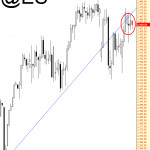Is the U.S. economy on solid footing? Federal Reserve Chairwoman Janet Yellen seems to think so. In particular, Yellen expressed confidence in household spending as well as job growth during prepared testimony before Congress on Thursday.
It is not surprising to see central bank authorities describe current economic circumstances in glowing terms. Later this month, members of the Federal Reserve Open Market Committee (FOMC) hope to hike borrowing costs for the first time in nine years.
Unfortunately, the U.S. economy may not be in the greatest shape for the Fed to act. For example, while the headline unemployment rate is only 5% – a condition that Yellen describes as close to full employment – the percentage of working-aged Americans (25-54) with a job has not been this low in more than three decades. (Back then, Michael Jackson was thrilling music fans with “Thriller” and Prince was going insane with “Let’s Go Crazy.”)

Let’s examine the chart above in detail. The 25-54 year old demographic is the prime working-aged sector of the American population. Grammy and grandpa are not the ones who have stopped working entirely; rather, millions upon millions of 25-54 year olds are no longer counted as participants in the workforce. Indeed, when you strip out millions upon millions of working-aged individuals, your headline unemployment rate is going to move lower. Yet that’s not full employment. How can we be close to full employment when 19.3% of 25-54 year old Americans don’t hold a job?
If you want to see genuine job growth, look no further than 1985-1989 and 1995-1999. During those periods, you see the percentage of 25-54 year olds with employment catapulting higher. During a five-year span (1989-1994) that encompassed the early 1990s recession? Jobs were hard to come by. That’s why one can see the flattening of the 25-54 year old demographic at that time. Similarly, one of the reasons that the mainstream media called the 2002-2007 economic expansion a “jobless recovery” was due to the flattening of the labor force participation rate in the 5-year run.














Leave A Comment